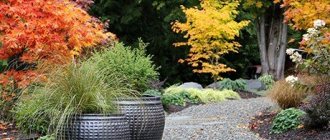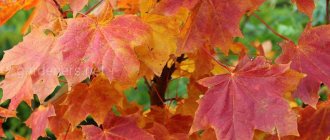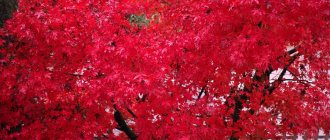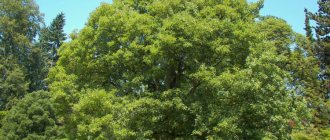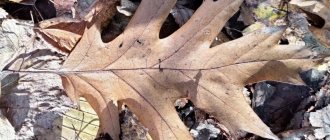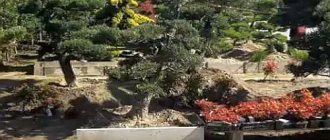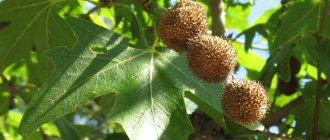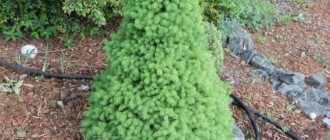| Maple Paperbark | |
| Acer griseum at Morton Arboretum Accession 836-58-7 | |
| Scientific classification | |
| Kingdom: | Plantae |
| Clade : | Tracheophytes |
| Clade : | Angiosperms |
| Clade : | Eudicots |
| Clade : | Rosida |
| Order: | Sapindales |
| Family: | Sapindaceae |
| Genus: | Acer |
| Variety: | A. griseum |
| Binomial name | |
| Acer griseum (Franch.) Pax 1902 | |
| Synonyms [1] | |
| |
Maple gray
The
Paperbark maple
(simplified Chinese: 血皮枫; traditional Chinese: 血皮楓; pinyin:
Xue Pí Feng
), is a species of flowering plant in the family Sapindaceae, native to central China.
[2] Acer griseum
is found in the Chinese provinces of Gansu, Henan, Hubei, Hunan, Shaanxi, Shanxi and Sichuan, at altitudes of 1,500–2,000 m (4,921–6,562 ft). [2]
Winter hardiness of maples in the Moscow region
In the gardens of Japan, Japanese maple, palmate maple and Shirasawa maple are used. All of them in central Russia are not winter-hardy. I wrote about winter hardiness on Wikipedia, read it there.
I am aware that the climate is changing. Japanese and palm maple have not been frozen out in St. Petersburg in recent years. But this is not your first year in Russia? If it stinks -45C in winter, no one will be surprised. Therefore, planting species that are not particularly winter-hardy in your garden is somewhat short-sighted.
During the 60 years of existence of the arboretum of the Main Botanical Garden of the Russian Academy of Sciences, winter hardiness and the influence of meteorological conditions on the growth and development of woody plants were constantly assessed. Significant fluctuations in temperature, humidity, snow cover and other meteorological factors made it possible to obtain an average stability assessment over 60 years, which is reflected in the book Woody Plants of the GBS RAS from 2005. I will give them (over time I will add data on other botanical gardens). Shorter observations of owners of private gardens are certainly interesting, but not significant. And the Internet opuses of copywriters that fill the entire RuNet are meaningless digital noise.
Bearded maple - Acer barbinerve
Tree up to 12 m tall or shrub. There have been 8 specimens growing in GBS since 1934. At the age of 9 years, height is 3.3 m, crown diameter is 2.3 m. Winter hardiness I. In the Ufa Botanical Garden, winter hardiness II. In Krasnoyarsk, winter hardiness is III. In Syktyvkar, winter hardiness is II-III; in severe winters it is VII.
Acer divergens
A shrub or small tree 3-4 m high. 3 specimens have been growing in the GBS since 1970. At the age of 5 years, the height is 2.1 m and the crown diameter is 90 cm. Winter hardiness - I, in severe winters - II-III.
Ginnala maple, or riverine maple - Acer ginnala
A small tree, often bushy. There have been 34 specimens growing in the GBS since 1938. Shrub, at the age of 40 years, height 9 m and crown diameter 4 m. Winter hardiness I. In the Ufa Botanical Garden, winter hardiness I. In Krasnoyarsk, winter hardiness - I. In Syktyvkar, winter hardiness - I. In Surgut, winter hardiness - I.
Naked maple - Acer glabrum
A small tree or shrub. There have been 8 specimens growing in GBS since 1966. Shrub, at the age of 10 years the height is 2 m and the crown diameter is 70-80 cm. Winter hardiness I. In Krasnoyarsk winter hardiness - II.
Gray maple - Acer griseum
Three specimens have been growing in the GBS since 1963. Shrub, at the age of 8 years the height is 0.6 m and the crown diameter is 40 cm. Winter hardiness I, in severe winters III-IV.
Hyrcanian maple - Acer hyrcanum
31 specimens have been growing in the GBS since 1951. Shrub, at the age of 24 years, height 3.6 m and crown diameter 2.4 m. Winter hardiness III. In the Ufa Botanical Garden, winter hardiness is III-IV.
Georgian maple - Acer ibericum
There have been 20 specimens growing in the GBS since 1951. Shrub, at the age of 20 years, height 1.2 m and crown diameter 1.6 m. Winter hardiness III, in severe winters IV-V.
Light maple - Acer laetum
Tree up to 20-25 meters tall. The trunk diameter is up to 40 cm. 10 specimens have been growing in the GBS since 1951. Shrub, at the age of 30 years the height is 3.6 m and the crown diameter is 1.7 m. Winter hardiness V.
Manchurian maple - Acer mandshuricum
Shrub or tree up to 10-20 meters tall. There have been 27 specimens growing in the GBS since 1951. Shrub or tree, at the age of 27 years, height is 4 m and crown diameter is 2 m. Winter hardiness at a young age is II, in adult plants I. In Syktyvkar, winter hardiness is I. In Surgut, winter hardiness is II-III.
Maple mono, or small-leaved - Acer mono
Tree up to 15 meters tall. 15 specimens have been growing in the GBS since 1951. Shrub or tree, at the age of 14 years, height is 3.2 m and crown diameter is 1.3 m. Winter hardiness I. In the Ufa Botanical Garden, winter hardiness I-II. In Krasnoyarsk, winter hardiness is I-III. In Syktyvkar, winter hardiness is I-II, in severe winters VII.
Montpelian maple, or three-lobed maple - Acer monspessulanum
Tree up to 12 meters tall. There have been 21 specimens growing in GBS since 1947. Shrub, at the age of 24 years, height 2.8 m and crown diameter 3.2 m. Winter hardiness II. In the middle zone it is not very decorative. In the Ufa Botanical Garden, winter hardiness is III-IV.
Ash-leaf maple, or American - Acer negundo
Tree up to 20 m tall. There have been 5 specimens growing in GBS since 1937. Tree, at the age of 27 years, height 8 m and trunk diameter 17 cm. Winter hardiness I. In the Ufa Botanical Garden, winter hardiness I. In Krasnoyarsk, winter hardiness - I-II. In Syktyvkar, winter hardiness is I (IV).
Black maple - Acer nigrum
Tree up to 40 m tall. One specimen has been growing in the GBS since 1966. Tree, at the age of 12 years, height 2.5 m and trunk diameter 2 cm. Winter hardiness I, in harsh winters II.
Viburnum leaf maple - Acer opalus
Tree up to 15 m tall. There have been 4 specimens growing in GBS since 1948. Shrub, at the age of 6 years, height 1.6 m and crown diameter 1.4 m. Winter hardiness III, in severe winters V. In Syktyvkar, winter hardiness - I (IV).
Palm or fan maple - Acer palmatum
Tree or shrub up to 15 m tall. One specimen has been growing in the GBS since 1948. Shrub, at the age of 11 years the height is 0.7 m and the crown diameter is 60 cm. It grows slowly. Winter hardiness III-V even with shelter. In the Ufa Botanical Garden, winter hardiness (with shelter) is II-III. Frosts up to 75% of annual growth.
Pennsylvania maple, or striped - Acer pensylvanicum
Tree up to 12 m tall. One specimen has been growing in the GBS since 1948. Tree, at the age of 30 years, height 4 m and trunk diameter 3 cm. Winter hardiness I.
Norway maple, or platanolea - Acer platanoides
Tree up to 30 m tall. 143 specimens have been growing in the GBS since 1937. Tree, at the age of 7 years the height is 3.2 m, at 50 years the height is 3.2 m; at 50 years old, height 18 m, trunk diameter 28 cm. Winter hardiness I. Winter hardiness of the 'Krimson King' variety - I; 'Drummondii' - I-II; 'Globosum' - I; 'Laciniatum' - III; 'Schwedleri' - I. In Syktyvkar - I-II(IV-V). In Krasnoyarsk, winter hardiness is I-III.
False sycamore maple, or Sycamore - Acer pseudoplatanus
Tree up to 40 m tall. There have been 33 specimens growing in the GBS since 1941. Tree or shrub, at the age of 20 years, height 6 m and crown diameter 4 m. Winter hardiness of adult plants - I, seedlings - II-IV. In Surgut, winter hardiness is IV.
Acer pseudosieboldianum
Tree up to 8 m tall. One specimen has been growing in the GBS since 1947. It grows slowly. Seedlings need shelter in winter and shade in summer. Winter hardiness - II. In the Ufa Botanical Garden, winter hardiness is III. In Krasnoyarsk, winter hardiness is V. In Syktyvkar, winter hardiness is I, in severe winters IV.
Pubescent maple - Acer pubescens
There have been 24 specimens growing in the GBS since 1952. Shrub, at the age of 20 years, height is 1.1 m, crown diameter is 1.4 m. At 37 years, height is 3 m, crown diameter is 2 m. Winter hardiness - II.
Red maple - Acer rubrum
Tree up to 40 m tall. There have been 16 specimens growing in GBS since 1939. Multi-stemmed tree, at the age of 11 years the height is 1.4 m and the crown diameter is 2 m. At the age of 30 years the height is 11 m, the crown diameter is 4 m. At the age of 50 years the height is 18.5 m, the trunk diameter is 27-35 cm. Winter hardiness I -II. In Syktyvkar, winter hardiness is I (but there is little data yet). In Surgut, winter hardiness is II-III.
Silver maple - Acer saccharinum
Tree up to 40 m tall. There have been 24 specimens growing in the GBS since 1938. Tree, at the age of 28 years, height is 15 m and trunk diameter is 23.5 cm. At the age of 50 years, height is 18 m, trunk diameter is 35 cm. Winter hardiness I. In the Ufa Botanical Garden, winter hardiness II.
Sugar maple - Acer saccharum
Tree up to 40 m tall. There have been 10 specimens growing in GBS since 1938. Tree, at the age of 14 years, height is 3.5 m and crown diameter is 1.5 m. At the age of 50 years, height is 9.5 m, trunk diameter is 16.5 cm. Winter hardiness I (occasionally II). In the Ufa Botanical Garden, winter hardiness II.
Maple Semenov - Acer semenovii
Tree up to 5 m tall, often bushy. 33 specimens have been growing in the GBS since 1947. Low branching tree, at the age of 10 years the height is 1.3 m and the crown diameter is 0.9 m. At the age of 27 years the height is 3.8 m, the crown diameter is 2.9 m. Winter hardiness II. In the Ufa Botanical Garden, winter hardiness II.
Spica maple - Acer spicatum
Shrub or tree up to 10 m tall. 41 specimens have been growing in the GBS since 1939. Bush. At the age of 13 years, the height is 2 m and the crown diameter is 1 m. At the age of 30 years, the height is 5.8 m and the crown diameter is 3 m. Winter hardiness I. In Syktyvkar, winter hardiness is I (but there is little data yet). In Surgut, winter hardiness is II.
Steven's maple - Acer stevenii
Tree up to 12 m tall. There have been 2 specimens growing in GBS since 1958. Bush. At the age of 30 years, the height is 3.2 m and the crown diameter is 2.3 m. At the age of 30 years, the height is 5.8 m and the crown diameter is 3 m. Winter hardiness II. Not very decorative.
Tatarian maple - Acer tataricum
Tree or shrub up to 8 m tall. There have been 23 specimens growing in the GBS since 1937. Tree. At the age of 40 years, the height is 11.5 m and the trunk diameter is 14 cm. Winter hardiness I. In the Ufa Botanical Garden, winter hardiness I. In Syktyvkar - I, in severe winters - IV. In Krasnoyarsk, winter hardiness is I. In Surgut, winter hardiness is I.
Greenbark maple - Acer tegmentosum
Tree up to 15 m tall. 18 specimens have been growing in the GBS since 1937. Tree or shrub. At the age of 20 years, the height is 3.6 m and the trunk diameter is 2.5 cm. At the age of 36 years, the height is 6.3 m and the crown diameter is 3 m. Winter hardiness I. In the Ufa Botanical Garden, winter hardiness II. In Syktyvkar, winter hardiness is I-II.
Four-dimensional maple - Acer stachyophyllum
Tree up to 10 m tall. One specimen has been growing in the GBS since 1954. Bush. At the age of 7 years, the height is 2 m and the crown diameter is 1.4 m. Winter hardiness II-III.
Heildrech's maple - Acer heldreichii
Tree up to 20 m tall. There have been 23 specimens growing in the GBS since 1937. Bush. At the age of 23 years, the height is 4 m and the crown diameter is 3 m. Winter hardiness III, adult plants - II.
Yellow maple - Acer ukurunduense
Tree up to 14 m tall. 25 specimens have been growing in the GBS since 1945. Bush. At the age of 28, the height is 7.8 m and the crown diameter is 3 m. Winter hardiness III. In the Ufa Botanical Garden, winter hardiness II. In Syktyvkar, winter hardiness is II, in severe winters III-IV. In Surgut, winter hardiness is II-III.
Links[edit]
- ↑
List of plants, Acer griseum (Franch.) Pax. - ^ abcde Flora of China (draft): Acer griseum
- https://www.maple-trees.com/pages/paperbark-maple.php
- Rushforth, K. (1999). Trees of Britain and Europe
. Collins ISBN 0-00-220013-9. - RHS AZ Encyclopedia of Garden Plants
. UK: Dorling Kindersley. 2008. p. 1136. ISBN 978-1405332965. - "RHS Plant Selection - Acer griseum". Retrieved February 23, 2020.
- "2015 North American-China Plant Exploration Consortium (NACPEC) Acer griseum Collection Expedition". Retrieved October 1, 2022.
- Van Gelderen, C. J., & van Gelderen, D. M. (1999). Maples for Gardens: A Color Encyclopedia
.
Formation of maples
All maples have fairly brittle wood and are mostly shaped by pruning rather than bending. Shoots are pruned twice a year, in mid-summer and winter. It is not advisable to prune in the fall, since this is the peak time for the spread of spores of many types of fungi that feed on wood. Whether to cover the cuts with something or not is an open question. After the leaves grow, some of them are removed, making the crown more openwork. Branches are pruned into rings.
Pruning branches into rings
If the gardener understands how the growth of shoots occurs, it is not difficult to control the formation of the crowns of trees and shrubs within a very wide range. Japanese gardeners work with a small number of plant species and are well aware of their shoot formation characteristics. But the Japanese experience is only partially applicable in our conditions, since completely different species can be grown in central Russia.
Changing the angle of inclination of skeletal branches is one of the most effective ways to regulate growth when forming the crown and pruning young plants. The more vertical the branch is, the stronger its growth and, conversely, the closer to horizontal, the weaker the growth. The awakening of dormant buds also depends on the position of the branch. On vertical branches, shoots from the apical and adjacent buds develop most strongly, but the buds located on the lower part of the branch awaken very weakly; in a horizontal position, the awakening of dormant buds increases, but the growth of each individual shoot is weaker.
Drawing from the article: Antonova I.S., Bart V.A., Klochkova P.S. On the structure of shoot systems of some species of the genus Acer L. 2016
All our winter-hardy maples can be roughly divided into two groups: straight-trunked and those growing in the form of a small tree or bush. A typical representative of the first group is the Norway Maple, the second is the Ginnala Maple. Representatives of the first group are trees of the upper tier of the forest and edge species. Representatives of the second group, as a rule, are plants that form the undergrowth. The methods used to form the two groups are somewhat different.
Upright trees
All maples tend to grow upward up to a certain age. Even in a large garden, this is not always appropriate. The main way to form nivaki from upright trees is to plant at an angle and then re-top it. When the top of a tree is removed, the top of the remaining shoots develop not according to the program of the lateral branch, but according to the program of the trunk. Leave the one that makes the trunk line curved. When the tree has reached the height desired by the gardener, all shoots growing upward begin to be removed. This technique is used with both deciduous and coniferous plants.
Drawing from the book: Niwaki: Pruning, Training and Shaping Trees the Japanese Way. Author: Jake Hobson, 2007
With the opposite arrangement of the buds, you can leave either two first-order branches at the same level, or one at a time. At the maples they leave one at a time. An even number of branches at one level, as a rule, does not look aesthetically pleasing. Symmetry in nivaki styles is informal.
Norway maple shoot. Drawing from the book: Anton Joseph Kerner von Marilaun, Adolf Hansen: Pflanzenleben: Erster Band: Der Bau und die Eigenschaften der Pflanzen. 1913
On the side shoots of the maple, one pair of buds is directed to the sides, and the next one is directed up and down (see picture above). As the branches grow, only those shoots are left that grow horizontally and improve the architecture of the crown. Which shoots should be left and which ones should be removed depends on the gardener’s goals and the characteristics of the landscape where the tree grows. We should not forget that the branches should not obscure each other.
Mature upright maples are formed by thinning the crown, removing part of the branches of the first and second orders, as well as all branches directed up and down. The goal of such work is to transform the tree crown from a voluminous green spot into something more aesthetically pleasing and structured.
Formation of a maple with a straight trunk. Drawing from the book: Niwaki: Pruning, Training and Shaping Trees the Japanese Way. Author: Jake Hobson, 2007
Many species of this genus tend to form forks with sharp corners, which leads to subsequent pinching of the bark and the formation of places easily infected by fungi. If you grow a tree from an early age, this problem can be easily prevented by timely pruning. In the case of mature trees, sharp forks are removed using the method shown in the figure below.
Drawing from the book: Formation and pruning of garden trees, Kudryavets R. 2014 a - suppression of the development of one of the branches by strong pruning to transfer to a weak branch; b – cutting out the remaining part of the branch after thickening the main one; The wound is small and heals well.
Maples growing as a bush or tree
Some types of maples that have the shape of a bush or tree have quite a lot of dormant buds located on branches of all orders, and often at the base of the trunk. The natural processes of crown formation are based on the implementation of the genetic program of plant development, the visible expression of which is designated as an architectural model. Through reiteration, a plant duplicates, reproduces, or restores its own architecture. Reiterates can occur in response to the natural aging of individual parts of the tree, shading patterns, traumatic events (which include pruning), or when the tree’s resource supply improves. Partial and complete traumatic reiteration occurs due to dormant kidneys. It is important for a gardener to understand which species can wake up in which places.
Drawing from the article: M.V. Kostina, N.S. Barabanshchikova, O.I. Yasinskaya. Study of the crown of ash maple (Acer negundo L.) from the perspective of the concept of architectural models and reiteration.
For example, in Ash Leaf Maple, the crown quickly recovers when the top part of the tree is removed. The only growth points in this case are dormant buds located at the base of the annual growths that form the trunk. These buds spring up along the entire length of the trunk. But the most powerful shoots, which over time will give rise to several daughter trunks, are formed from dormant buds located directly under the cutting site. This feature is used to reduce the height of the tree and completely rebuild the crown architectonics.
One should not think that by pruning a maple tree and directing the growth of its top and branches, the gardener is doing something unnatural for the tree. In Ashleaf Maple, in uneven lighting, the angle of deviation of the trunk from the vertical can reach 30–40°. In addition, trunks often also have, to varying degrees, a pronounced horizontal section up to 5–6 m long. Thanks to this plasticity of growth, the crown of the tree can shift to more favorable lighting conditions.
In 25% of young trees of this species, at the end of summer, the tip of the shoot, which takes part in the formation of the trunk, dries up on its own. Thus, the tilting and curvature of the trunks occurs due to natural overtopping.
Drawing from the article: M.V. Kostina, N.S. Barabanshchikova, O.I. Yasinskaya. Study of the crown of ash maple (Acer negundo L.) from the perspective of the concept of architectural models and reiteration.
Maples growing as a bush or tree usually form an umbrella or multi-stemmed tree. The height is determined by the landscape where the maple tree is located and the ease of its maintenance. Typically, the height of the tree is kept at a level convenient for working with it from human height or from a stepladder. There's not much to invent here. If you have a good understanding of the plants of this group, it is easy to understand in which direction to form the crown. Observation is not created quickly. But studying the art of bonsai helps a lot here. Look at photographs, go to exhibitions and analyze how masters shaped this or that plant.
Formative pruning of maple
Maples under 15 years old tend to grow new and skinny shoots, without side branches. This problem is exacerbated by pruning, which is often done by the impatient tree owner, hoping to create a beautiful crown sooner than is possible. It is better not to touch the tree as long as possible. You will be surprised to find that with age, the long and thin shoots have become the basis of the crown skeleton and formed beautiful side branches.
Text: Dmitry Konstantinov, 2021
As an appendix to this article, you can consider a gallery of photographs of maples.
Cultivation and use[edit]
Acer griseum
was introduced into cultivation in Europe in 1901 by Ernest Henry Wilson for Veitch Nurseries in the UK and shortly thereafter in North America.
It is one of many maple species widely grown as ornamentals in temperate regions. It is admired for its decorative peeling bark, translucent pieces of which often remain attached to the branches until worn off. It also has spectacular fall foliage that can include reds, oranges and pinks. Varieties include columnar Copper Rocket.
This plant received the Royal Horticultural Society's Garden Merit Award. [6]
In 2015, the North American China Plant Research Consortium (NACPEC) conducted an expedition specifically designed to collect Acer griseum seeds.
in order to increase the genetic diversity of cultivated plants.
[7] Propagation in gray maple
is quite difficult as the seeds have the same parthenocarpic tendencies as those of
Klen Maksimovic
. [8]

